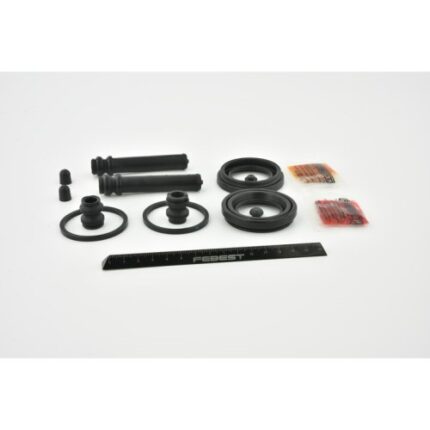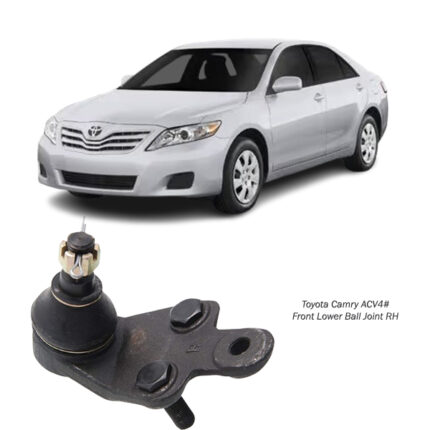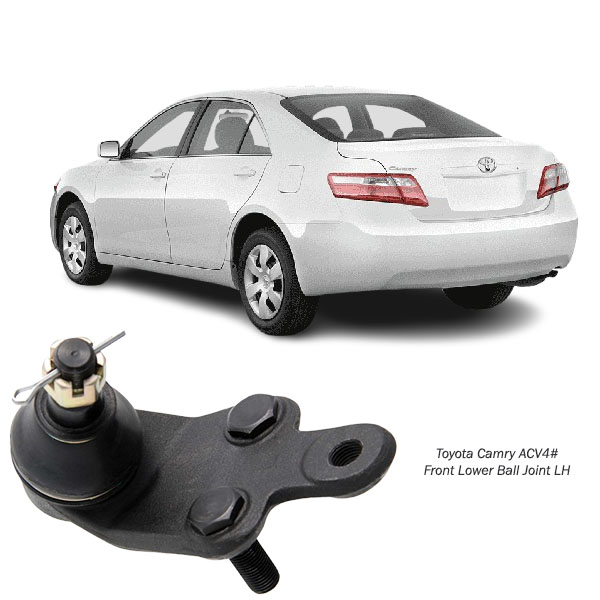-17%
Get Toyota Camry ACV4#/AVV50 Front Lower Ball Joint LH 0120-GSV40LH in Kenya
The front lower ball joint is a critical component of a vehicle’s suspension system, connecting the lower control arm to the steering knuckle. This joint allows for controlled movement and rotation of the steering knuckle, which is essential for steering and suspension articulation. Here’s a deep dive into its definition and function:
Definition and Structure
1. Basic Definition:
A front lower ball joint is a spherical bearing that enables the connection and articulation between the lower control arm and the steering knuckle. It acts as a pivot point, allowing the steering knuckle to move vertically with the suspension while also rotating horizontally with the steering input.
2. Components:
- Ball Stud: A hardened steel stud with a spherical end, which fits into the socket.
- Socket: A metal or polymer housing that encases the ball stud, allowing for rotational movement.
- Boot: A rubber or polyurethane cover that protects the joint from dirt, debris, and moisture, ensuring longevity and smooth operation.
- Grease Fitting (sometimes): Some ball joints come with a grease fitting to allow for periodic lubrication, extending the component’s life.
Benefits;
1. Improved Steering Precision and Control:
- Smooth Steering Response: The front lower ball joint allows for precise control of the steering knuckle, enabling smooth and responsive steering movements.
- Accurate Steering Feedback: A good ball joint provides accurate feedback from the road to the driver, enhancing the overall driving experience and control over the vehicle.
2. Enhanced Suspension Performance:
- Flexibility in Suspension Movement: The ball joint allows for up and down movement of the suspension, accommodating changes in road surface and absorbing shocks from bumps and potholes.
- Stability During Cornering: By maintaining proper alignment of the suspension components, the ball joint helps ensure vehicle stability and reduces body roll during cornering.
3. Improved Ride Comfort:
- Reduced Vibration and Noise: A well-functioning ball joint minimizes vibrations and noise transmitted from the road, contributing to a smoother and quieter ride.
- Consistent Ride Quality: By maintaining the alignment and proper functioning of the suspension system, the ball joint helps preserve consistent ride quality over various road conditions.
4. Extended Tire Life:
- Even Tire Wear: Properly functioning ball joints help maintain correct wheel alignment, preventing uneven tire wear and extending the lifespan of the tires.
- Reduced Tire Stress: By ensuring the wheels remain in proper alignment, the ball joints reduce unnecessary stress and strain on the tires.
5. Enhanced Vehicle Safety:
- Reliable Handling: Good ball joints are essential for reliable vehicle handling, especially in emergency situations where precise steering is crucial.
- Stability During Braking: Proper ball joint function helps maintain stability and control during braking, reducing the risk of skidding or loss of control.
6. Durability and Longevity of Suspension Components:
- Reduced Wear on Suspension Parts: By maintaining proper alignment and movement of the suspension components, the ball joint reduces wear and tear on other parts of the suspension system.
- Extended Service Life: High-quality ball joints are designed to withstand the stresses of daily driving, contributing to the overall durability and longevity of the suspension system.
7. Cost-Effectiveness:
- Lower Maintenance Costs: Well-functioning ball joints reduce the need for frequent alignments and tire replacements, lowering overall maintenance costs.
- Preventive Maintenance: Regular inspection and maintenance of ball joints can prevent more severe and costly suspension system failures.
Signs a car needs a new;
1. Excessive Engine Movement:
- Visible Engine Movement: Excessive movement of the engine, particularly during acceleration, deceleration, or shifting gears, suggests that the engine mounts are not providing adequate support.
- Engine Rocking or Shifting: Noticeable rocking or shifting of the engine when starting or stopping the engine is a clear indicator of worn mounts.
2. Increased Vibrations and Noise:
- Cabin Vibrations: A significant increase in vibrations felt inside the cabin, especially at idle or during acceleration, often points to failing engine mounts. These vibrations can become more pronounced as the mounts deteriorate.
- Unusual Noises: Clunking, banging, or knocking noises coming from the engine bay, particularly during acceleration or deceleration, are symptomatic of loose or damaged engine mounts. These noises occur because the engine is moving excessively and making contact with other components.
3. Poor Engine Alignment:
- Misalignment of Engine Components: Worn engine mounts can lead to the misalignment of various engine components, such as the exhaust system or driveshafts, causing abnormal contact, wear, or noise.
- Strained Hoses and Cables: Misaligned engine components can place undue stress on hoses and cables, potentially causing them to stretch, crack, or disconnect.
4. Steering and Handling Issues:
- Steering Problems: Worn engine mounts can affect steering responsiveness and stability. The vehicle may feel less controlled or experience difficulty maintaining a straight line.
- Reduced Handling: Compromised engine mounts can lead to handling issues, especially during cornering or sudden maneuvers, as the engine’s shifting weight affects the vehicle’s balance.
5. Visual Inspection:
- Visible Damage or Wear: A thorough visual inspection of the engine mounts can reveal cracks, tears, or other damage in the rubber or metal components. Any signs of wear or deterioration indicate that the mounts need to be replaced.
- Leaking Fluid: Some engine mounts are hydraulic or fluid-filled to enhance vibration damping. Fluid leakage from these mounts is a clear sign of failure.
6. Abnormal Engine Behavior:
- Engine Sag: If the engine appears to be sagging or sitting lower in the engine bay than usual, it can indicate that the mounts are not holding the engine securely.
- Delayed Engine Response: A delay in engine response when accelerating or shifting gears can result from excessive engine movement due to worn mounts.
Follow us on Facebook for more parts.



